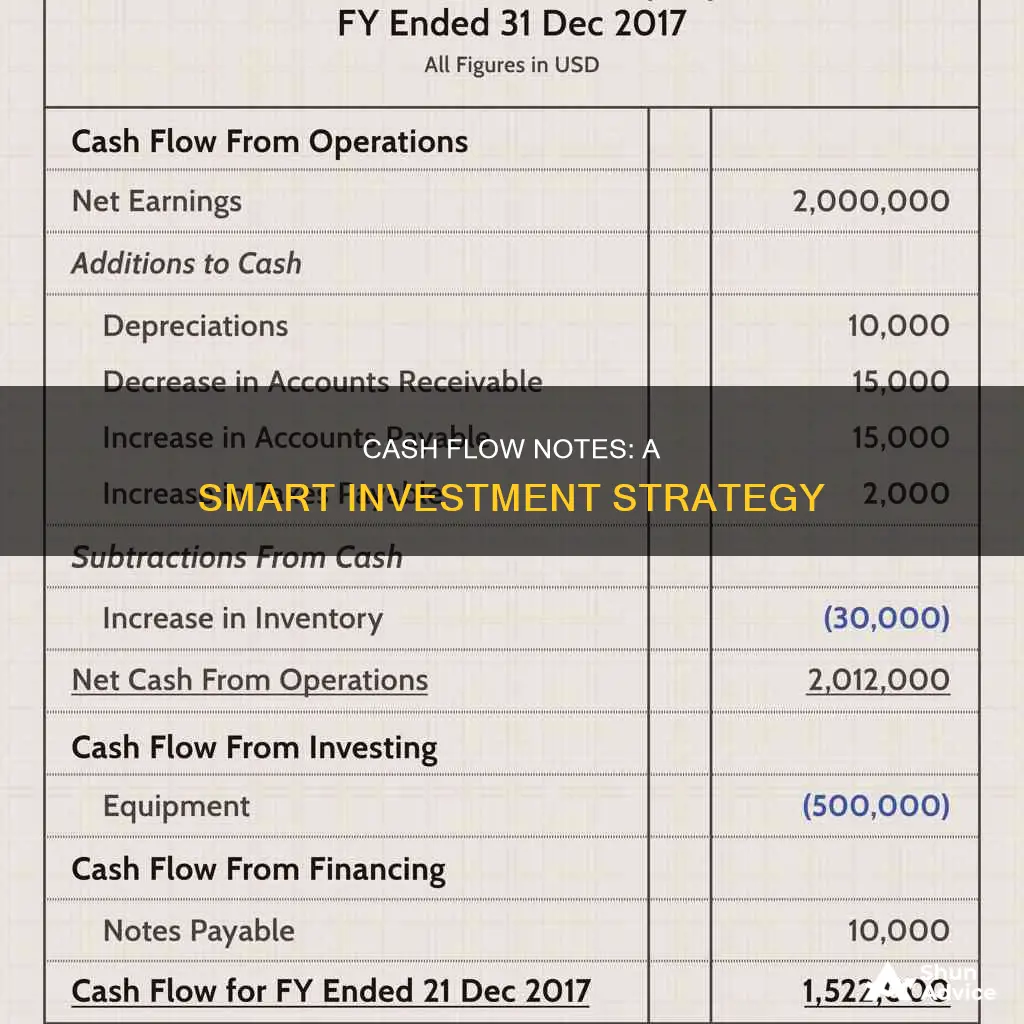
Cash flow notes are a type of debt instrument, IOU, or promissory note. They are created when an individual or business borrows money from another party, and the note serves as proof of the debt. Those looking to invest in cash flow notes can do so by purchasing them and becoming the lender in the transaction. This means that the borrower will repay the loan amount, plus interest, to the investor. Cash flow notes can be purchased through brokers or banks, and it's important to understand the terms and conditions, such as the principal amount, interest rate, and repayment term. By investing in cash flow notes, individuals can earn monthly cash flow through interest payments from the borrower.
| Characteristics | Values |
|---|---|
| What are cash flow notes? | Cash flow notes are a debt instrument, IOU, or promissory note. |
| When are cash flow notes used? | When an individual or business borrows money from another individual or business. |
| Who is involved? | The lender and the borrower. |
| Who benefits? | Individuals who wish to earn money can buy cash flow notes and make money by earning interest from the repayment of the notes from the borrower. |
| Different types of cash flow notes | Notes on businesses or real estate. |
| How to buy cash flow notes? | Contact a business broker for business cash flow notes or a mortgage broker for mortgage cash flow notes. |
| How to transfer ownership? | Create a promissory note that shows the owner of the note and the borrower as the responsible party for repayment. |
| How to facilitate the transaction? | Create an escrow account, a third-party account where the money for the cash flow notes deposits and disbursements occur. |
What You'll Learn

How to buy business cash flow notes
Cash flow notes are a type of debt instrument, IOU, or promissory note. They are proof of debt when an individual or business borrows money from another party. When you buy cash flow notes, you become the lender, and the borrower repays you the loan amount plus interest.
Step 1: Decide on the Type of Cash Flow Notes
First, determine the type of cash flow notes you want to buy. This could include notes on businesses or real estate. If you want to buy business cash flow notes, you will need to contact a business broker.
Step 2: Contact a Broker
Find a local business broker through an online search or phone book. Get in touch with them to express your interest in buying cash flow notes and inquire about the available options.
Step 3: Discuss Terms and Conditions
Find out the principal amount, interest rate, and the remaining term of the cash flow note. For example, you may expect to earn 12-15% on a mortgage cash flow note.
Step 4: Create a Promissory Note
As the new lender, you will need to create a promissory note that establishes you as the owner of the note and the borrower as the party responsible for repayment.
Step 5: Set Up an Escrow Account
An escrow account is a third-party account where the money for the cash flow notes is deposited and disbursed according to the terms and conditions of the note. You can ask the broker to set up an escrow account, or you can hire an attorney to do so.
Step 6: Deposit the Purchase Money
Since you are buying the cash flow note, you must deposit the purchase price into the escrow account. The administrator of the account will then disburse this money to the seller of the note.
Step 7: Collect Monthly Payments
As the owner of the cash flow note, you will receive the monthly payments, including principal and interest, from the borrower. Typically, the borrower pays into the escrow account, and the administrator disburses the money to you.
By following these steps, you can invest in business cash flow notes and earn money through the interest on the repayment of the notes.
Unlocking Investment Opportunities with Cash-Out Refinancing
You may want to see also

How to buy mortgage cash flow notes
Investing in mortgage cash flow notes can be a great way to generate passive income and diversify your portfolio. Here's a step-by-step guide on how to buy mortgage cash flow notes:
Step 1: Understand Mortgage Notes
Mortgage notes are financial documents outlining the loan agreement between a borrower and a lender, including the repayment schedule and interest rate. Performing mortgage notes represent loans where borrowers consistently make their payments, offering a steadier income stream and lower risk. On the other hand, non-performing notes are riskier but present opportunities for higher returns through foreclosure or loan restructuring.
Step 2: Decide on Your Investment Profile
Determine your risk tolerance, preferred loan-to-value ratio, type of asset securing the debt instrument (e.g., residential, multifamily), and borrower profile (FICO score, debt-to-income ratio). These factors will help you define your investment criteria and identify suitable mortgage notes.
Step 3: Find a Broker or Intermediary
Engage the services of a mortgage broker or intermediary who acts as a liaison between the seller of the notes and you, the buyer. They can help you find and evaluate suitable mortgage cash flow notes within your investment criteria. You can also approach banks directly, particularly their asset management or special assets department, which handles the sale of distressed or non-performing loans.
Step 4: Analyze the Note
Once you've identified a prospective note, analyze its terms and conditions, including the principal amount, interest rate, and term. Assess the borrower's creditworthiness by evaluating their payment history and credit score. Also, consider the underlying property's condition, location, market value, repair needs, and depreciation factors, as these will impact the note's worth.
Step 5: Make an Offer
Based on your analysis, present an offer that compensates you for the risk of owning the note. Consider factors such as the current yield, debt yield, loan exposure to the current asset value, and the borrower's financial status when determining a fair price.
Step 6: Finalize the Purchase
If your offer is accepted, hire a lawyer to create an assignment of the promissory note, transferring ownership of the lien rights and benefits to you. You will need to open an escrow account, where the money for the note deposits and disbursements will be managed according to the promissory note's terms and conditions. Deposit the purchase price for the note into the escrow account, and the seller will receive the funds upon closing the deal.
Step 7: Collect Your Payments
As the new owner of the mortgage cash flow note, you will receive monthly payments, including principal and interest, from the borrower. These payments are typically made into the escrow account, and the administrator will disburse the money to you. Alternatively, you can hire a servicing company to handle the note servicing function for a reasonable fee, making this investment truly passive.
Smart Ways to Invest a Windfall of $150K Cash
You may want to see also

How to create a promissory note
A promissory note is a legally binding agreement that lays out the details of a loan. It is a contract that includes the loan amount, repayment obligations, loan costs, and the lender's recourse in the event of the borrower's default. Here is a step-by-step guide on how to create a promissory note:
- Title the Document: Begin by giving the document a clear title, such as "Promissory Note," to indicate the nature of the agreement.
- Identify the Parties: Include the full legal names and addresses of both the borrower and the lender to establish their identities.
- State the Loan Amount: Clearly specify the principal amount of the loan to avoid any misunderstandings.
- Define the Terms: Outline the interest rate, repayment schedule, and due date. Specify whether the loan will be repaid in installments or as a lump sum.
- Include Signatures: Both parties must sign the document to make it legally binding. Consider using an online signature generator for convenience.
- Specify Collateral (if applicable): If the loan is secured with collateral, define what it is and when the lender can take possession of it.
- Payment Amount and Frequency: Detail the payment amount and how often payments will be made.
- Co-signer (if applicable): If there is a co-signer, include their name and have them sign the document as well.
- Signing and Storing: While not required, it is often a good idea to have a lawyer review the promissory note. Once the document is drafted, have all parties sign and date it. Make photocopies or scans, and store the original document in a safe place.
- Amendments: If changes need to be made to the promissory note, create a separate amendment agreement outlining the modifications. Have all parties sign the amendment, and attach it to the original promissory note.
It is important to use clear and concise language throughout the promissory note to avoid ambiguity. Additionally, consulting a legal professional can help ensure that the document complies with local laws and regulations.
Cash App Investing: Dividends and Your Money
You may want to see also

How to create an escrow account
An escrow account is a third-party account where money for cash flow notes is deposited and disbursed according to the promissory note and the terms and conditions of the note. The broker can set up an escrow account, or you can hire an attorney to do so. Here is a step-by-step guide on how to create an escrow account:
Step 1: Decide on the Type of Escrow Account
First, determine the type of escrow account you need. There are two main types: escrow for insurance and escrow for taxes. You can choose to have either or both, depending on your needs and requirements.
Step 2: Identify a Reputable Escrow Company
Research and select a reputable escrow company that will act as a neutral third party to facilitate the transaction. The escrow company should be licensed and have experience handling similar transactions. You can ask for referrals from your broker, attorney, or other trusted sources.
Step 3: Provide Necessary Documentation
The escrow company will require specific documents to set up the account. These may include identification, proof of address, and other relevant information. Make sure you have all the required documents ready to provide to the escrow company.
Step 4: Fund the Escrow Account
Once the account is set up, you will need to fund it. Deposit the required amount into the escrow account as specified in the terms and conditions of the cash flow note. The funds will be held in the account until they are disbursed according to the agreed-upon terms.
Step 5: Monitor the Escrow Account
It is important to monitor the escrow account regularly to ensure that funds are being deposited and disbursed correctly. Stay in communication with the escrow company and review statements to confirm that transactions are accurate and timely.
By following these steps, you can create an escrow account to facilitate the purchase of cash flow notes. Remember to seek professional advice and do your due diligence to ensure a smooth and secure transaction.
Cash vs Investing: Is Holding Cash Ever Better?
You may want to see also

How to collect monthly payments
Once you have purchased a cash flow note, you become the lender, and the borrower must pay you back the principal amount of the loan, plus interest.
The borrower will typically pay their monthly payments into an escrow account, and the administrator of this account will then disburse the money to you.
You can keep this process passive by hiring a servicing company to handle the monthly payments, accounting, statements, and tax and water payments. This will usually cost a set-up fee of around $150, plus a monthly fee of $10-$15 per loan.
Cash Value Investing: Strategies for Long-Term Wealth Preservation
You may want to see also
Frequently asked questions
Cash flow notes are a type of debt instrument or IOU, where an individual or business borrows money from another party. The note serves as proof of the debt, and can be secured (accompanied by a mortgage or UCC document) or unsecured. When you buy a cash flow note, you become the lender, and the borrower repays you the principal amount plus interest.
There are various types of cash flow notes, including those for businesses or real estate. The type of note you choose will depend on your investment goals and risk tolerance.
To begin investing in cash flow notes, you'll need to decide on the type of note you want to purchase. Then, you can contact a broker (either a business or mortgage broker, depending on the type of note) to discuss the terms and conditions of the note, including the principal amount, interest rate, and repayment term.







